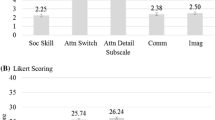Abstract
This study examined the validity and the internal and interrater reliability of the Wing Subgroups Questionnaire (WSQ), an assessment that classifies children with autism into one of three subtypes. Subjects were 42 students enrolled in multihandicapped special education classrooms. Results indicated that items pertaining to the active-but-odd and the aloof subtypes, and to typical development, demonstrated good consistency, whereas passive subtype items showed moderate consistency. Interrater reliability was good for all subtypes utilizing intraclass correlations, but it was moderate with regard to percentage agreement of subtype diagnosis. Interscale correlations were mostly low or negative, suggesting that the subtype scales are measuring distinct constructs. Significant differences among the subtypes were found on three measures of communication, three measures of social interaction, two measures of stereotypic behavior, and one measure of temper/aggression.
Similar content being viewed by others
References
American Psychiatric Association. (1994).Diagnostic and statistical manual of mental disorders (4th ed.). Washington, DC: Author.
Borden, M. C., & Ollendick, T. H. (1994). An examination of the validity of social subtypes in autism.Journal of Autism and Developmental Disorders, 24, 23–37.
Castelloe, P., & Dawson, G. (1993). Subclassification of children with autism and pervasive developmental disorder: A questionnaire based on Wing's subgrouping scheme.Journal of Autism and Developmental Disorders, 23, 229–241.
Cohen, D. J., & Donnellan, A. M. (1987). Preface. In D. J. Cohen, A. M. Donnellan, & R. Paul (Eds.),Handbook of autism and pervasive developmental disorders (pp. xv-xx). New York: Wiley.
Cohen, D. J., Paul, R., & Volkmar, F. R. (1987). Issues in the classification of pervasive developmental disorders and associated conditions. In D. J. Cohen, A. M. Donnellan, & R. Paul (Eds.),Handbook of autism and pervasive developmental disorders (pp. 20–40). New York: Wiley.
Dunn, L. M., & Dunn, L. M. (1981).Peabody Picture Vocabulary Test-Revised manual. Circle Pines, MN: American Guidance Service.
Individuals with Disabilities Education Act. (1990, October). Public L. No. 101-476, 104 STAT. 1103–1151.
Krug, D. A., Arick, J., & Almond, P. (1980). Behavior checklist for identifying severely handicapped individuals with high levels of autistic behavior.Journal of Child Psychology and Psychiatry, 21, 221–229.
Rutter, M., & Schopler, E. (1992). Classification of pervasive developmental disorders: Some concepts and practical considerations.Journal of Autism and Developmental Disorders, 22, 459–482.
Sparrow, S. S., Balla, D. A., & Cicchetti, D. V. (1984).Vineland Adaptive Behavior Scales: Survey form manual. Circle Pines, MN: American Guidance Service.
Volkmar, F. R., Cohen, D. J., Bregman, J. D., Hooks, M. Y., & Stevenson, J. M. (1989). An examination of social typologies in autism.Journal of the American Academy of Child and Adolescent Psychiatry, 28, 82–86.
Wadden, N. P., Bryson, S. E., & Rodger, R. S. (1991). A closer look at the Autism Behavior Checklist: Discriminant validity and factor structure.Journal of Autism and Developmental Disorders, 21, 529–541.
Wing, L., & Attwood, A. (1987). Syndromes of autism and atypical development. In D. J. Cohen, A. M. Donnellan, & R. Paul (Eds.),Handbook of autism and pervasive developmental disorders (pp. 3–19). New York: Wiley.
Wing, L., & Gould, J. (1979). Severe impairments of social interaction and associated abnormalities in children: Epidemiology and classification.Journal of Autism and Developmental Disorders, 9, 11–30.
Author information
Authors and Affiliations
Additional information
This article is based upon dissertation research which fulfilled part of the author's requirements for a Doctor of Psychology degree in school psychology at the University of Pittsburgh. I gratefully acknowledge the assistance of Louis A. Chandler for his editorial comments on a draft of this article. I also thank Rebecca Simmons for her computer expertise in typing the tables.
Rights and permissions
About this article
Cite this article
O'Brien, S.K. The validity and reliability of the Wing Subgroups Questionnaire. J Autism Dev Disord 26, 321–335 (1996). https://doi.org/10.1007/BF02172477
Issue Date:
DOI: https://doi.org/10.1007/BF02172477



